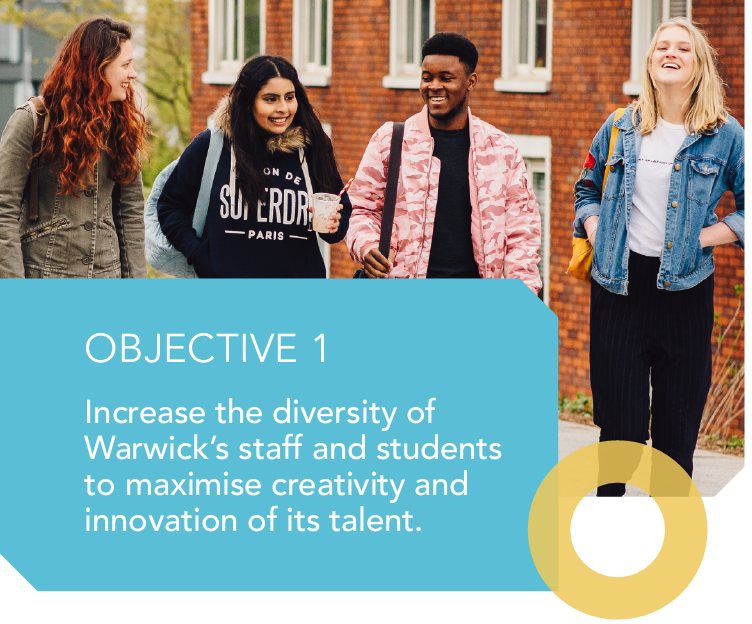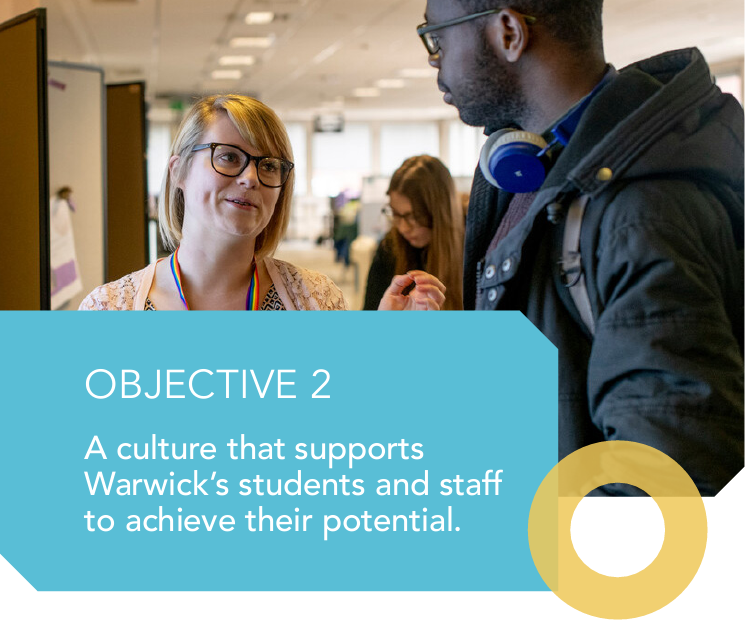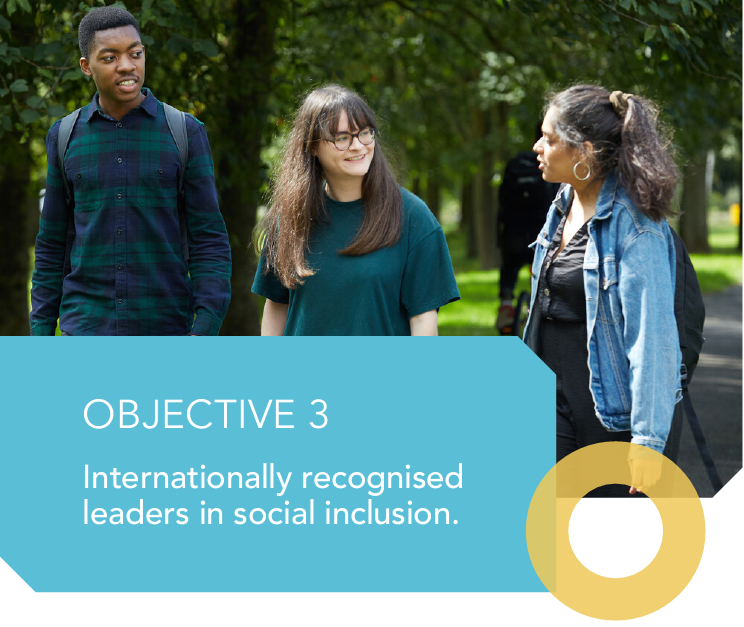Objectives
The social inclusion agenda at Warwick aims to make a real difference by nurturing the most diverse and inclusive citizens and leaders for today and tomorrow, and that through inclusive practice, Warwick can leverage the benefits of difference to help the University achieve its vision. Work will continue into identifying talent that has found itself excluded and under-represented in Higher Education. By removing barriers and changing the way things are done, Warwick can provide an inclusive experience of outstanding academic and professional growth at the University for both its students and staff.
At Warwick, diversity is about all members of its community. Warwick’s approach will go much further than the bounds of legislative practice, protected characteristics and the requirements of regulators. It is leadership at all levels of the University’s community that will be central to driving the structural changes required to see everyone living Warwick’s values and nurturing a culture that truly recognises, respects and fosters diversity.

Research and experience indicates that certain diversity characteristics result in greater challenges for some people in higher education. In particular, there are more challenges for people of BAME (Black, Asian and Minority Ethnic) origin; disabled people; and people who come from economically disadvantaged backgrounds. This is manifested in numerous ways, but most obviously in access to higher education and academic attainment. Warwick’s approach will focus on ensuring it tackles these barriers and practices to specifically address these issues. The effects of intersectionality when considering diversity will be central to the analysis and actions subsequently undertaken.
Our strategic objectives to 2030 are to:
- Increase the diversity of Warwick’s staff and students to maximise creativity and innovation of its talent.
- Develop a culture that supports students and staff in achieving their potential.
- Become an internationally recognised leader in social inclusion.

Diversity of thought leads to innovation and creativity. Inherited and acquired diversity characteristics are indicators of diversity of thought. Representing different experiences and approaches, it brings fresh challenge to ways of thinking and doing things.
For Warwick, having diversity represented in its students and staff means that the University can achieve its vision of excellence in education and research. This can be measured through the protected characteristics and economic background of its staff and students and these indicators will continue to be a key focus of the University’s progress on increasing inclusion. Headway on closing the attainment gap for Warwick’s students, and in particular for those of specific BAME backgrounds, those with disabilities and those from economically disadvantaged backgrounds, will be key indicators of success. For staff, measures of career progression and pay equity will be primary indicators of real change across the academy and in professional services.
Our work on this: We have identified a number of KPIs to support these objectives, focusing on improving widening participation student access, closing the Black awarding gap, increasing diversity of staff at senior levels, and closing the University's pay gaps.
Diversity in Warwick’s Students
As a Russell Group University, Warwick recognises that traditional methods of recruiting students, coupled with reputation, have inadvertently resulted in a lack of diversity for certain groups of people. It is understood that this has created barriers and significant work is being undertaken to redress them. Warwick is proud of the progress that it has made in the increases in BAME student recruitment compared to its Russell Group peers. However, the University will continue to examine how best it can reach out to, engage with potential students, and work with them to ensure they are informed and supported through the application process. The regional ethnic diversity of communities makes this a priority for Warwick. On the University’s part, systems and processes are needed that ensure that it is identifying talent and making offers to entry based on criteria that truly recognises potential in all its diversity.
As a university, Warwick is constantly striving to improve how it does things to make its student experience among the best in the world. It is recognised that the University needs to understand how its teaching, learning, and assessment approaches impacts on its students. As the student life cycle is reviewed, measures will be introduced that help to provide better indicators of which students are likely to face challenges in reaching their potential and make available options for timely and appropriate interventions.
Warwick has made great strides in improving women’s experience, by working towards and achieving an institutional Silver Athena Swan award. However, to truly achieve gender equality for its students, Warwick will continue to identify and work on challenges as it works towards all academic departments achieving an Athena Swan award. Warwick has also established a good foundation for eliminating racial discrimination by achieving a Bronze Race Equality Charter, and work on its action plan will help improve the experience of BAME students and staff at the University.
The attainment gap is one of the most pressing challenges affecting particular groups of BAME students, disabled students, and from economically disadvantaged backgrounds. Through co-creation with students and academics, Warwick is working towards inclusive teaching practices, curriculum, and teaching spaces that provide reasonable adjustments. This will be done by:
- Co-creation with affected groups.
- Underpinning by research and learning from peers.
- Systemic and structural change that goes beyond supporting affected groups separately.
- Enhancement-driven monitoring (to make immediate and then structural change).
Our work on this: As part of the University's Inclusive Education Model work, a dashboard has been developed to help departments understand their current situation in regard to any awarding gaps within their undergraduate student cohort. This is used as a starting point and supporting resource to help identify any inclusion issues departments may have and to inform planning.
Diversity in our staff
Increasing diversity in all staff, including academic, professional and other support staff, particularly at senior levels, is essential to bring inclusion to the student experience, and to enhance Warwick’s reputation and brand as an inclusive employer. Reviewing recruitment and promotion processes to ensure unbiased decision-making and nurturing talent to establish a diverse talent pipeline are some of the actions that will support the University in its drive for a diverse workforce: a workforce whose diversity and inclusive leadership will be inspirational for Warwick’s students and the communities that it works with.
Equity in pay for all staff is one of the ways that high performance can be rewarded and diverse talent valued. Reduction, and ultimately elimination, of the gender and ethnic minority pay gap is a priority, which must be achieved. Through better understanding, the barriers to career progression and decision-making about reward and recognition, Warwick can work towards achieving this outcome. Improving diversity data will support the improvement of the pay gap for women and ethnic minorities and it will promote better understanding of how it affects other groups of staff, in particular those with specific protected characteristics.
Our work on this: In our annual report - 'Closing Our Pay Gaps' - we provide information on pay gaps at the University for the snapshot date of 31 March. We analyse this data and look at the context for the figures, and we set out our continued commitment to improve pay gaps at the University, through steps we’ve already put in place and the further actions we have identified.


